Alps are the largest mountain system in Europe. The snow-capped peaks and deep valleys of the Alps are among Europe’s most spectacular sights.
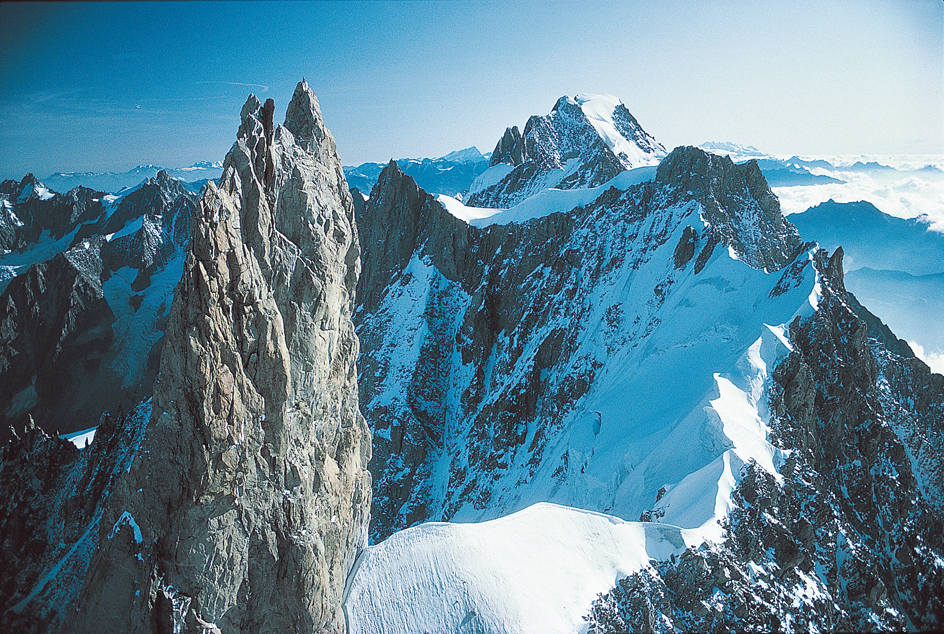
The Alps stretch across south-central Europe in a broad arc. The mountains extend from the Mediterranean Sea and run along the border between France and Italy. The Alps then stretch northward and eastward through northern Italy, Switzerland, Liechtenstein, southern Germany, Austria, and Slovenia. The mountain system forms a chain about 660 miles (1,060 kilometers) long and covers an area of about 80,000 square miles (210,000 square kilometers). The broadest part of the Alps is about 160 miles (260 kilometers) wide, and the narrowest part is less than 100 miles (160 kilometers). The highest Alpine peak, Mont Blanc, rises 15,771 feet (4,807 meters) on the border between France, Italy, and Switzerland. Other famous peaks in the Alps include the Matterhorn, at 14,692 feet (4,478 meters); Monte Rosa, at 15,203 feet (4,634 meters); Jungfrau, at 13,642 feet (4,158 meters); and Grossglockner, at 12,461 feet (3,798 meters).
The Alps form a natural barrier between central and southern Europe. The Romans gained control of the Alpine region between 58 and 15 B.C. and built roads through several Alpine passes. The roads allowed communication and trade between people on opposite sides of the Alps. Today, highways and railroads enable people to travel easily through the mountains. The two St. Gotthard tunnels, a highway and a railroad tunnel, run through the Alps in south-central Switzerland.
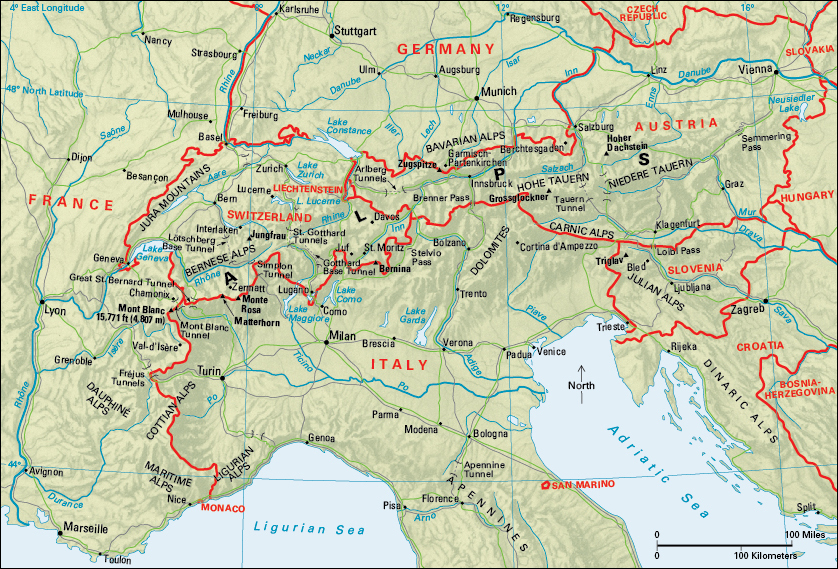
How the Alps were formed.
Geologists believe that a large sea once covered what is now the Alpine region. More than 100 million years ago, the land masses north and south of this sea began to move closer together. The great pressure placed on the seabed layers forced the land masses to fold gradually and to tilt, so that ridges and valleys formed. Rock that once lay deep below the seabed was pushed to the top of ridges. The central parts of the Alps include such rocks as gneiss, granite, schist, and shale. The southern and northern Alps consist chiefly of rugged limestone formations.

Glaciers covered most of the Alps until about 10,000 years ago. Since then, the ice cover has gradually retreated to the highest mountain parts. As the glaciers moved downhill and outward from the mountain core, they gouged the earth and rock, creating U-shaped valleys, cirques, and cols. Cirques are bowl-shaped hollows near the peak of a mountain. A col is a high pass between two cirques.
The Alpine glaciers also moved earth and rock that had collected along the edges and top of the ice. As the ice melted, rock debris piled up along the glacier’s path in bands called moraines. Some of these moraines formed natural dams across valleys, creating lakes as water collected behind the dams. The major Alpine lakes that were created by the erosive force of glaciers include Lake Como, Lake Constance, Lake Garda, Lake Geneva, Lake Maggiore, the Lake of Lucerne, and Lake Zurich. Today, there are over 1,000 small glaciers in the Alps. The largest is the Aletsch Glacier in southern Switzerland. However, most of the glaciers have thinned out or retreated considerably. Many of the smaller icefields have disappeared completely. See Glacier ; Moraine .
Chief ranges of the Alps.
Most geographers divide the Alpine region into the western, central, and eastern Alps. The western Alps include the ranges west of the Great St. Bernard Pass, which is between northwestern Italy and southwestern Switzerland. The Cottian, Dauphine, Graian, Ligurian, Maritime, and Savoy Alps are considered western Alps. The central Alps lie between the Great St. Bernard Pass and Lake Constance. They include the Bernese, Lepontine, Pennine, Rhaetian, and Valais Alps. The eastern Alps extend east of Lake Constance and consist of the Bavarian, Carnic, Dinaric, Julian, and Noric Alps; the Dolomites; Karawanken; and the Tauern.

Climate.
In general, the Alps have a temperate mountain climate. Such a climate is typically cooler and wetter than that of surrounding areas. The Alps are affected by the humid, temperate influences of the North Atlantic in the west and the drier continental influences, with greater seasonal temperature variations, in the east.
The Alps form a divide between the climate of central Europe to the north and west and the climate of the Mediterranean to the south. The land to the north and west of the Alps has a temperate climate with warm summers, cool winters, and precipitation throughout the year. The regions south of the Alps have hot and dry summers, mild winters, and precipitation mainly during the winter.
The Alps frequently experience warm, dry, violent winds, called foehns, that blow downward from the mountains into the valleys. These winds melt snow and ice on the mountainsides, often causing avalanches.
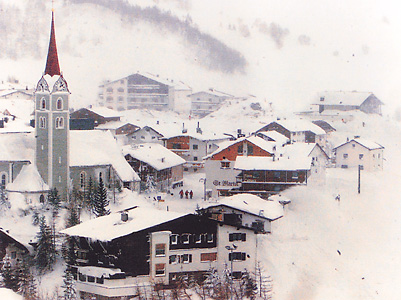
Plant and animal life.
Vegetation varies at different locations and elevations in the Alps. The valleys at the base of the Alps are filled mainly with grasslands. Beech and oak trees grow on the lower slopes. Fir, pine, and spruce trees cover the higher slopes. Alpine meadows appear at high elevations where trees cannot grow. Lichens, mosses, rock, shrubs, and ice and snow cover the highest elevations of the Alps.
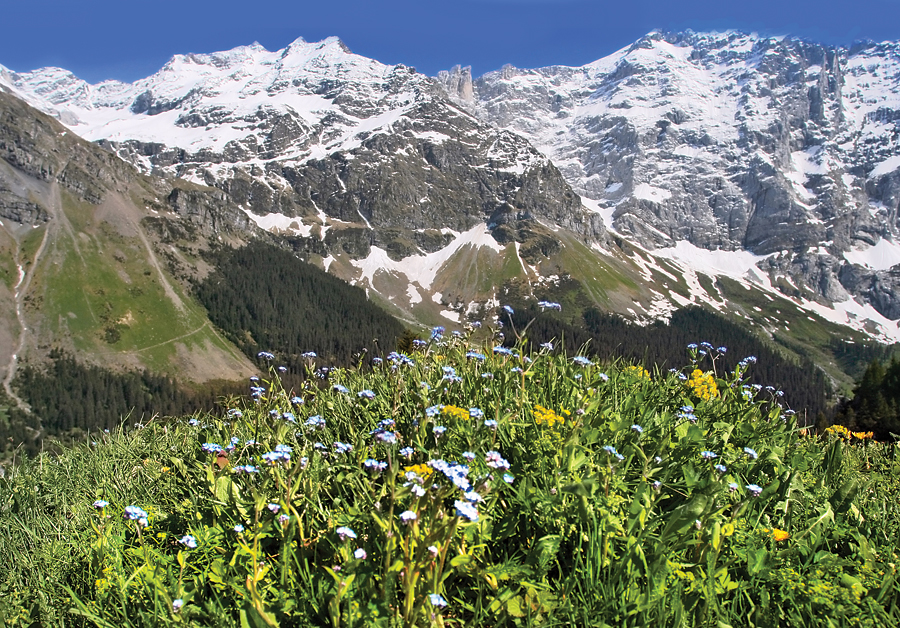
Many species of animals live in Alpine forests and meadows. They include chamois, sometimes called goat antelopes; deer; foxes; and ibexes, a type of wild goat. Eagles and falcons live among the highest peaks.
Agriculture and industry.
Most farming is done in the valleys and on the sunny lower slopes of the Alps. Small family-owned farms are most common. The chief crops include such grains as barley, oats, and rye. Traditional Alpine farmers raise cattle, goats, and sheep. Dairy farming is also an important economic activity.
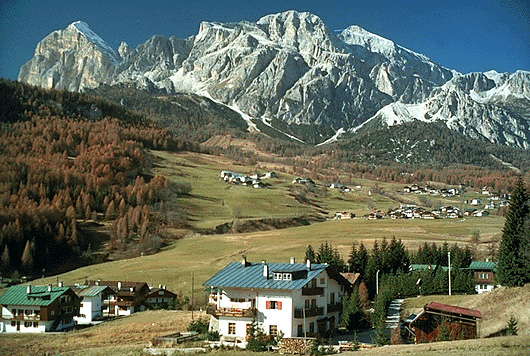
A variety of industries operate in the foothills and valleys of the Alps. Factories manufacture chemicals, electrical machinery, and other equipment. Traditional handicrafts still produced in the region include ceramics, shoes and other leather goods, and textiles.
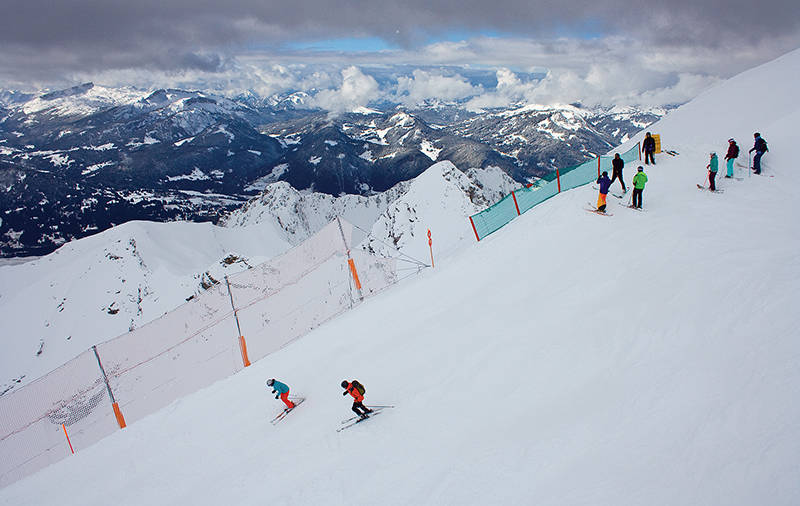
Natural resources found in the Alps include bauxite, iron ore, stone, and timber. Many factories run on hydroelectric power that is generated by waterfalls in the mountains. Hydroelectricity also powers most railroads in the region. Power plants in the Alps transmit some electric power to other parts of Europe.
Tourism is important to the economy of the Alps. Well-known Alpine resort communities include Chamonix in France, Lucerne and St. Moritz in Switzerland, Berchtesgaden in Germany, Cortina d’Ampezzo in Italy, and Innsbruck and Salzburg in Austria.
Alpine travel.
More than 40 passes occur naturally in the Alps. Highways and railroads have been built through many of them. The Brenner Pass, 4,508 feet (1,374 meters) high, is the most widely used pass in the eastern Alps. It lies between western Austria and northern Italy and has both a major highway and railroad.
In addition, tunnels have been built through the mountains beneath several of the passes. The St. Gotthard Road Tunnel in south-central Switzerland is 10.5 miles (16.9 kilometers) long and is one of the longest highway tunnels in the world. It is part of the St. Gotthard Road, the most-traveled route through the central Alps running between western Germany and Italy. The Gotthard Base Tunnel is the longest railroad tunnel in the world. It extends 35 miles (57 kilometers) beneath the Swiss Alps. The Simplon Tunnel, another railroad tunnel, links Switzerland and northwest Italy. The Great St. Bernard Tunnel was the first major highway tunnel to connect Italy and Switzerland. The Fréjus Tunnels and the Mont Blanc Road Tunnel link France and Italy.
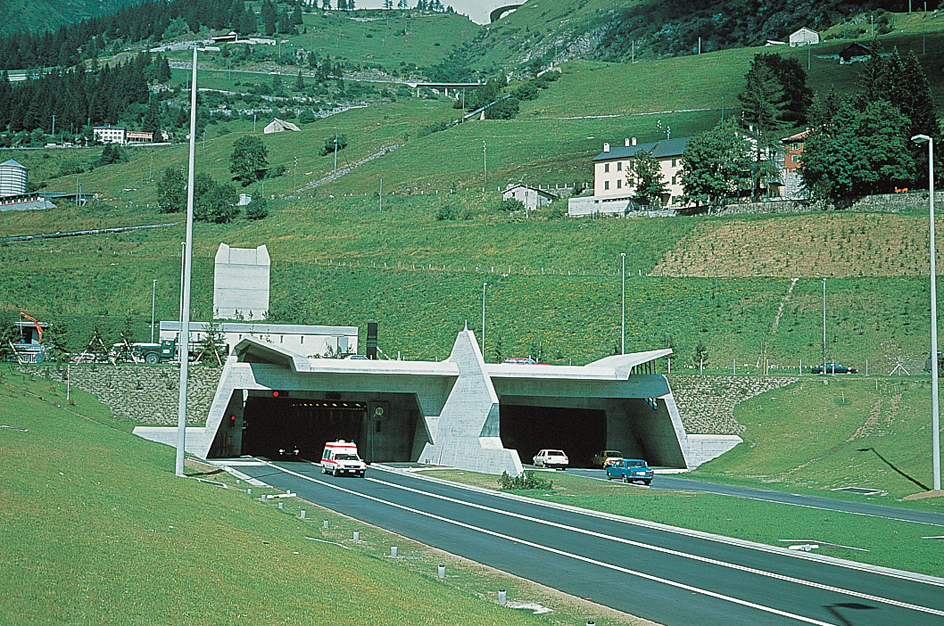
Climbing the Alps.
Few people attempted mountaineering in the Alps until the 1700’s, when scientists began to study the landforms and the biology of the region. In 1786, two Frenchmen, physician Michel G. Paccard and his guide, Jacques Balmat, became the first to reach the top of Mont Blanc. They recorded scientific observations along the way.
Many of the Alpine peaks were climbed for the first time during the mid-1800’s, when mountaineering gained popularity as a sport. In 1855, a group of Swiss and British climbers made the first successful climb to the top of Monte Rosa. In 1865, climbers reached the top of the Matterhorn for the first time. Most Alpine summits were conquered by 1900. Mountain climbing in the Alps became even more popular in the 1900’s. Today, professional guides use modern equipment to help people scale the highest peaks. Each year, thousands of people climb to the top of the Matterhorn.
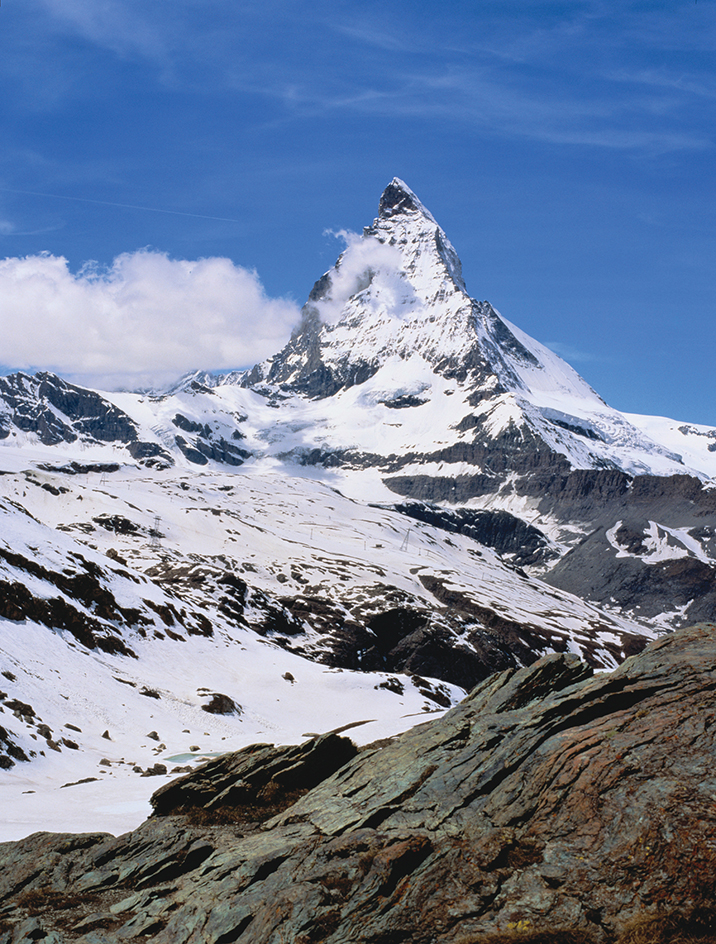
History.
People have lived in the Alps for thousands of years. By the 500’s B.C., Celtic tribes controlled much of the region. From 58 to 15 B.C., the Romans conquered the Alpine Celts. The Romans established settlements and engaged in agriculture, forestry, and mining. The Romans also built roads through various Alpine passes to link Rome with its northern provinces. The roads enabled the Romans to expand their influence into parts of northern Europe. These roads came to rank among the busiest in Europe due to Roman trade with the north.
The Roman Empire collapsed in western Europe during the A.D. 400’s. Through the centuries, the Alpine region came under the control of a number of empires and states. Travel in the Alps gradually became more difficult after the Romans lost control of it. However, government officials, merchants, religious leaders, and soldiers continued to use Roman roadways to cross the mountains.
During the late 1800’s, the first railroads crossed the Alps. This improvement in transportation led to the rapid growth of tourism in the region. Today, travelers can cross the Alps in less than eight hours by highway or railroad. Trans-Alpine routes have increased trade among the Alpine countries and between northern and southern Europe. But environmental pollution and overdevelopment generated by growth in highway traffic and tourism are a concern.

